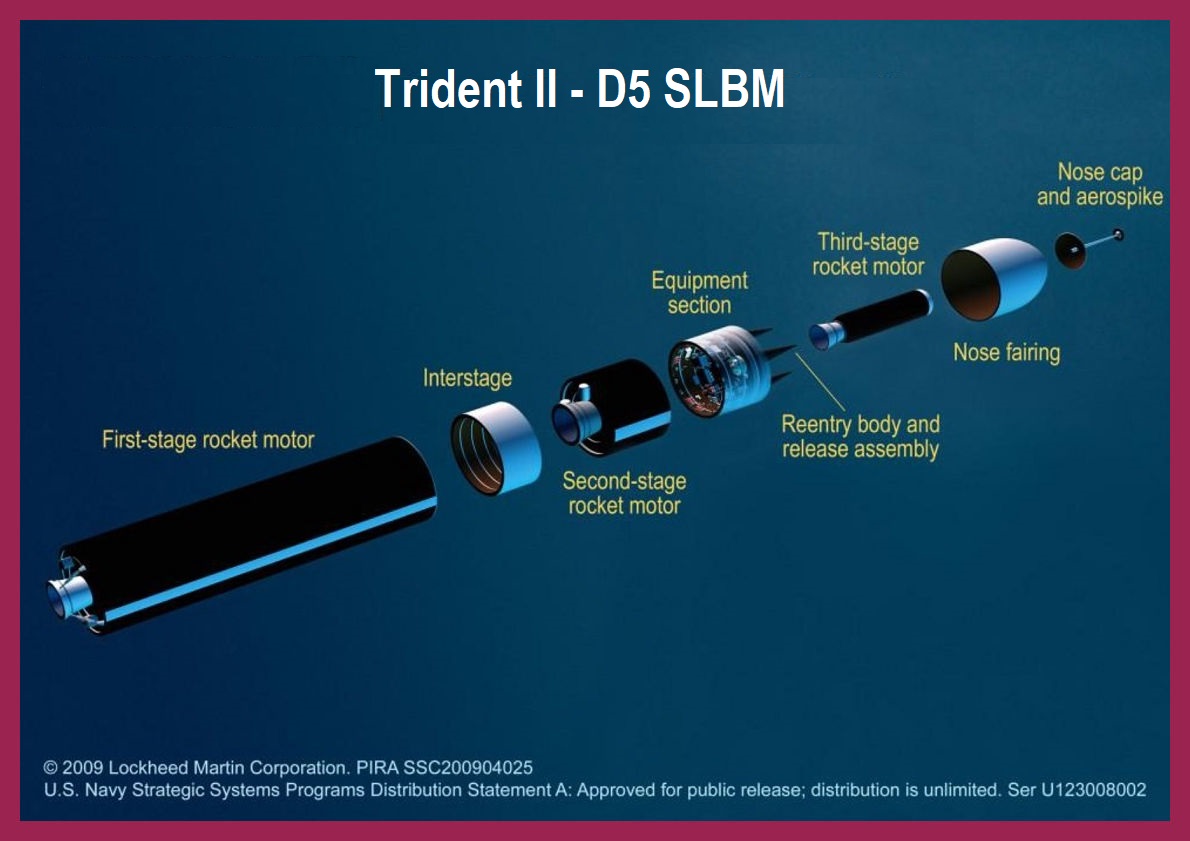
|

|
Trident II-D5 SLBM - The U.S. Navy's Nuclear Armed Submarine Launched Ballistic Missile
SLBM is a Navy acronym for Submarine Launched Ballistic Missile.
Missile Guidance is provided to the missile by the MK-6 Astro-Inertial
Guidance System, and is capable of receiving GPS updates.
The astro-inertial guidance uses star positioning to fine-tune the accuracy of the
inertial guidance system after launch. As the accuracy of a missile is dependent
upon the guidance system knowing the exact position of the missile at any
given moment during its flight, the fact that stars are a fixed reference point
from which to calculate that position makes this a potentially very effective
means of improving accuracy. In the Trident system, this was achieved by a
single camera that was trained to spot just one star in its expected position.
These missiles, and their fourteen, hidden, undetectable launch platforms known
as Ohio Class SSBN submarines, constitute one-third of the nuclear triad
of the United States. Their mission is one of "nuclear deterrence".
The submarines are designed specifically for stealth, and the missiles are
designed for the precise delivery of a significant number of nuclear
warheads.
General Characteristics: SLBM
Contractor:
* Lockheed Martin Space
Unit Cost:
* $30.9 million
Propulsion:
* 3 Solid Fuel Rocket Motors
Length:
* 44.5 feet (13.579m)
Diameter:
* 6 ft. 11 inches (2.11m)
Weight:
* 130,000 pounds
Range:
* >7,500 miles
Maximum Speed:
* Approximately 18,030 mph (29,020 km/h) (Mach 24; 8,060 m/s) (terminal phase)
Guidance System:
* MK-6 Astro-Inertial Guidance System
Steering System:
* Single movable nozzle actuated by a gas generator
Launch Platform:
* SSBN Submarines
Warhead Options:
* 1 to 8 MK-5 RV/W88 (455 kt) or
* 1 to14 MK-4 RV/W76-0 (100 kt) or
* 1 to14 MK-4A RV/W-76-1 (90 kt)
* Single or Multiple W76-2 (5-7 kt)
|
The Trident II D-5 Launch Sequence Occurs As Follows: |
|
Before the launch sequence is initiated, the on-board MARK 6 navigation system |
|
Once the launch command is given, a steam generator system is activated, |
|
Within seconds, the missile breaches the surface, and the first-stage Thrust |
|
Soon thereafter, the first-stage motor ignites and burns for approximately 65 |
|
When the first-stage motor ceases operation, the second-stage TVC subsystem |
|
Once the first stage is cleared, the second-stage motor ignites and burns for |
|
When the nose fairing is cleared of the missile, the third-stage TVC subsystem |
|
When the third-stage motor reaches the targeted area, the Post Boost Control |
|
The equipment section, with the MIRV, then aims the reentry vehicles (RV) |
Trident II - D5 SLBM Documentary Video
Videos are embedded and played in the web page. Click on the arrow in the
center of the window to play the video. If a video fails to play embedded,
try playing it on YouTube® by clicking on the Watch on YouTube link in the
lower left corner of the window.